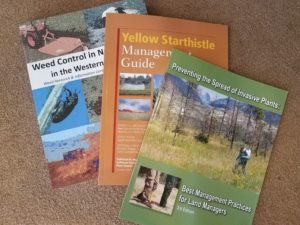Go to: Best Management Practices Manuals | Reports | Books | Brochures
Best Management Practices Manuals and Guides
BMP manuals and guides may be downloaded as free PDFs.
Durable Ignition Reduction Toolbox (2025) — This toolbox includes flowcharts and BMPs for roadside weed management to reduce ignition risk in Southern California.
Preparing for Wildland Fire: A Step-by-Step Guide for NPS Invasive Plant Managers (2023) — Wildfires – and wildfire response – present a significant risk for the spread of invasive plants. This guide describes steps that can be taken to avoid, minimize, or mitigate the introduction and spread of invasive species before and during wildland fire incidents. Although some protocols are specific to the NPS, the overall approach is generally transferable to other organizations.
Land Manager’s Guide to Developing an Invasive Plant Management Plan (2020) — This comprehensive guide was created for land managers to use when developing invasive plant management plans. It lays out a step-wise, easy-to-follow process designed to be applicable at any scale.
BMPs for Non-Chemical Weed Control (2020) — This manual provides comprehensive descriptions of 21 commonly used non-chemical weed control techniques and of biological control agents for 18 weed species/species groups that will help you as a practitioner treat weeds more effectively.
Prevention BMPs for Central Sierra Tree Mortality Zones (2019) — This manual provides best practices for contractors and land managers in the Central and Southern Sierra to avoid the spread of invasive weeds during tree removal and the associated disturbance. The zipped file also includes a 1-page Plant ID for our selected set of priority invasive species, and a PowerPoint of the Tree Mortality BMP for education and outreach.
Prevention BMPs for Sierra Meadow Restoration (2019) — This 12-page guide describes best management practices to prevent weed and pathogen spread while restoring Sierra Nevada Meadows
BMPs for Protecting Wildlife When Using Herbicides (2015) — This manual helps wildland managers further minimize the potential impacts to wildlife from herbicide applications, based on practices developed by those in the field and on the latest toxicology for particular herbicides.
Prevention BMPs for Land Managers (2012) — This manual presents a set of voluntary prevention measures and ready-to-use checklists to help those managing wildlands, including BMPs for fire and fuel management.
Prevention BMPs for Transportation and Utility Corridors (2012) — These voluntary guidelines help to prevent the introduction and spread of invasive plants along transportation and utility corridors, where vehicular traffic, construction, and maintenance activities can introduce or spread seeds and other propagules through project materials and ground disturbance.
Reports
Reports may be downloaded as free PDFs.
Protecting Central Coast Habitat for Listed Plant Species: Santa Cruz, San Benito, Monterey, San Luis Obispo, Santa Barbara, and Ventura Counties, California (2024) — This project plans for climate-smart invasive plant management to improve climate resilience of federally listed species and sensitive habitats within the California Central Coast region.
Protecting Rare Plants from Invasive Plants: Risk Assessment and Habitat Assessment for Federally Listed Plants in the Central Coast Region of California (2023) — This report analyzes the risk of impacts from invasive plants to more than seven hundred populations of fifty federally listed plant species in the central coast of California.
Stewarding California’s Biodiversity: Early Detection and Rapid Response (EDRR) for Invasive Plants (2020) – This white paper describes the strategic advantages of an EDRR approach, puts the need for such an approach in context, and provides a suite of recommendations for action at the statewide level.
Central Valley Arundo: Distribution, Impacts and Management (2020) — From 2016-2019, Cal-IPC mapped Arundo donax populations at high resolution across California’s Central Valley, a 38.4 million acre project area that includes the foothills. The project area is broken into 25 watershed units in which we calculate four types of impact (water, geomorphology, fire, sensitive species) based on the amount of Arundo present and other factors. We then integrate the impact for each watershed unit with an assessment of local capacity to build and implement a long-term Arundo removal program. From these integrated factors, we suggest priorities and make management recommendations.
Five-Year Invasive Plant Management Plan for the Central Reserve of the Nature Reserve of Orange County and Adjacent Lands (2019) – The reserve comprises lands owned by multiple owners and is managed under a Natural Communities Conservation Plan (NCCP). Cal-IPC produced a plan that determines which invasive plant species are a highest priority to control within defined management units. The plan also prescribes EDRR surveys in high-risk areas to find any new invasive plant populations.
Sierra Meadows Research Review and Study Recommendations (2019) – This report provides both a review of research on the effects of non-native plants on native mountain meadow systems and a proposed experimental design for evaluating species-specific effects on meadow systems.
Sierra Meadows Invasive Plant Vulnerability Index (2019) This report describes an index that Cal-IPC has developed for scoring vulnerability of Sierra Nevada meadows to invasion by non-native plants.
Bioinvasions in a Changing World: A Resource on Invasive Species-Climate Change Interactions for Conservation and Natural Resource Management (2014) — This report provides an overview of the connections between invasive species and climate change, then looks at how these communities approach conservation and natural resource management.
Blueprint for Coordinated Landscape-Scale Management of Invasive Plants in California (2013) — In 2013, representatives from state and federal land management agencies met through the California Interagency Noxious and Invasive Plant Committee to develop a strategic blueprint for landscape-level invasive plant management in California.
Arundo donax Distribution and Impact Report (2011) — From 2008-2010, Cal-IPC mapped Arundo donax at high resolution on all coastal watersheds in California from Monterey to San Diego. Impacts from Arundo invasion were calculated over the study area, including impacts to biomass production, water use, fire, geomorphic and fluvial processes, and endangered species.
Prioritizing Regional Response to Invasive Plants in the Sierra Nevada (2011) — This report presents statewide risk maps and priority management recommendations for 43 invasive plant species selected to be of special importance for the Sierra Nevada region of California. You may also be interested in the associated PDF report, Prioritizing Regional Response to Invasive Plants in the Southern Sierra.
Research Needs for Invasive Plants in California (2009) — This summary of major research needs for California invasive plants can be used to inform state policy and provide ideas for researchers, especially graduate students.
Use of Fire for Controlling Invasive Plants (2006) — This report captures the current state of knowledge on the use of fire as a tool to manage invasive plants in wildlands.
Invasive Plant Inventory — The California Invasive Plant Inventory categorizes non-native invasive plants that threaten the state’s wildlands. Categorization is based on an assessment of the ecological impacts of each plant. The Inventory represents the best available knowledge of invasive plant experts in the state.
Books
These books below are available for sale.
Weed Control in Natural Areas in the Western United States (2013) — Published by the University of California Weed Research & Information Center (Joseph M. DiTomaso et al.), this volume includes biology and control methods for 340 species.
Weeds of California and Other Western States (2006) — This two-volume, 1900-page book is the most comprehensive weed identification book ever produced in the United States.
Aquatic and Riparian Weeds of the West (2003) — This reference manual combines stunning photography with complete information for weed identification and biology. More than 550 photos illustrate 170 species of submerged, floating leaf, and emergent aquatic weeds, including common riparian invaders such as Arundo donax, purple loosestrife, Harding grass, Spartina species, and Russian olive.
Yellow Starthistle Management Guide (2006) — This guide begins with a description of the biology and ecology of yellow starthistle and provides a comprehensive overview of treatment methods for yellow starthistle.
The books below are only available in digital format.
The Weed Workers’ Handbook (2004) — Published by the Watershed Project and Cal-IPC, the Weed Workers’ Handbook explains how to remove more than 35 of the San Francisco Bay Area’s most invasive plants. (out of print – available as a PDF)
Invasive Plants of California’s Wildlands (2000) — This book provides specific information about the biology and control of 78 nonnative plant species that are listed by Cal-IPC as being of greatest ecological concern in California. (out of print – available as a PDF)
Brochures
Some “Don’t Plant a Pest!” brochures are available as print copies.
Don’t Plant a Pest! — Provides alternatives to invasive plants for gardeners, landscapers, and others in the horticultural community. Versions for San Francisco Bay Area, Southern California (English and Spanish), Trees of California, and Aquatic Plants are all available as print copies.
Brochures below are out of print and are available as a PDF download only.
Arundo: Streamside Invader – Known as giant reed, Arundo donax poses a major threat to riparian habitat. Learn why and what you can do to help. This brochure was produced for the California Department of Fish and Game by the Sonoma Ecology Center.
Biological Pollution — What you should know about invasive plants in California. This PDF file introduces a general audience to the ecological and economic impacts of invasive plants.
Contaminacion Biologica — Lo que usted debe saber acerca de plantas invasoras en California. Este folleto introduce a una audiencia general los impactos ecológicos y económicos de las plantas invasoras. La versión en español esta disponible sólo en un formato PDF.
Pampasgrass and Jubata Grass Threaten California Coastal Habitats. PDF
Perennial Pepperweed (Lepidium latifolium): Foreign Invader in California’s Wildlands PDF

